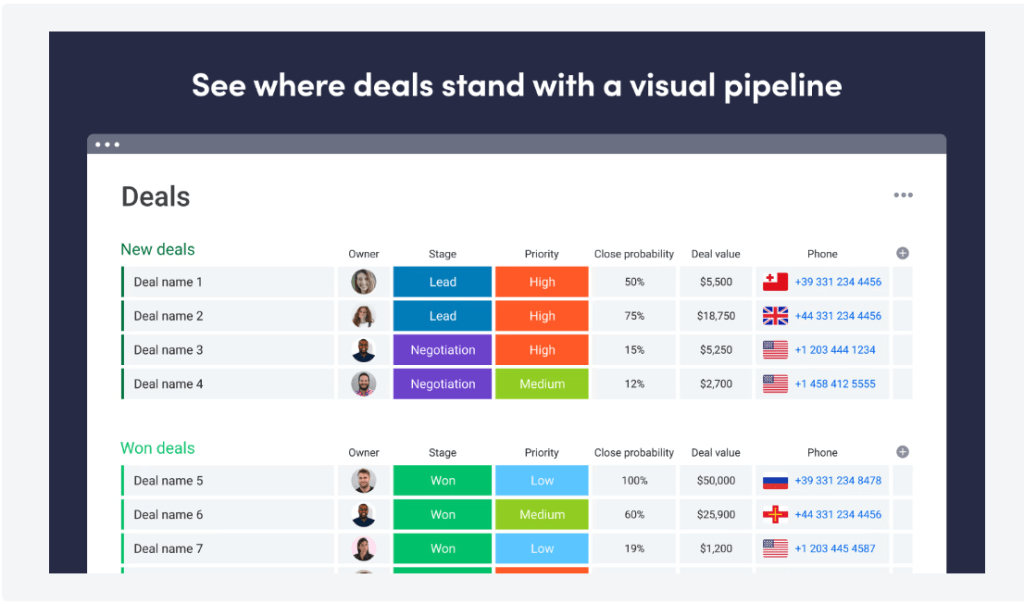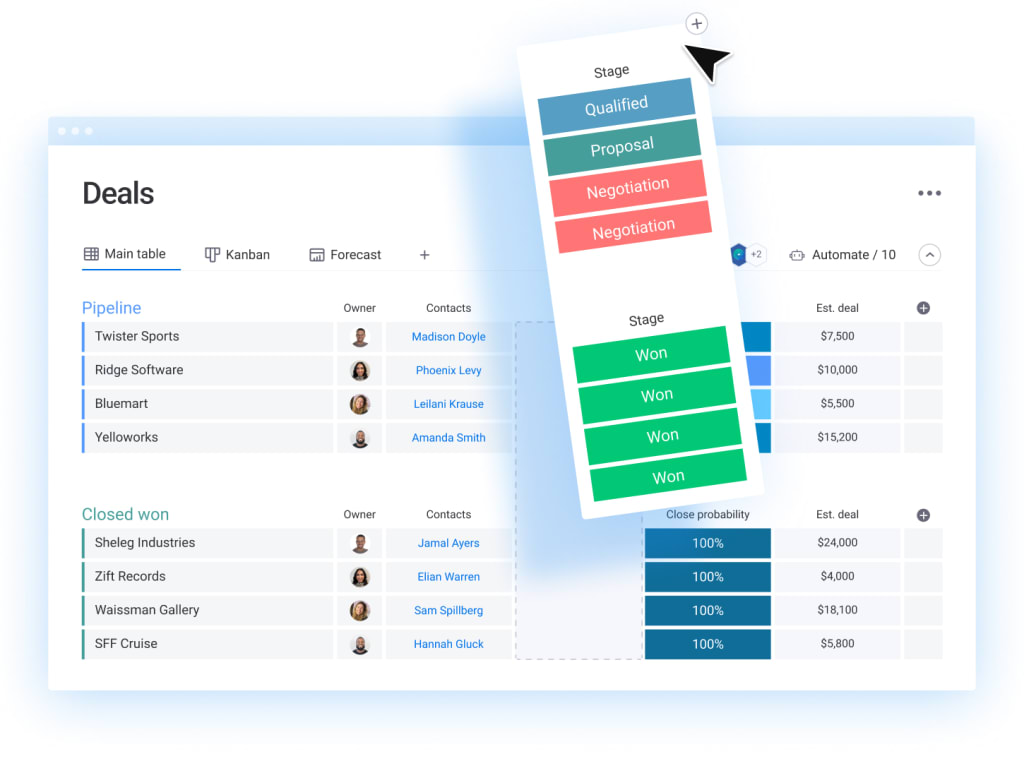Sales are without a doubt a core part of your company’s success. But more than selling, do you know how fast you’re getting leads through your pipeline and making the sale? That’s sales velocity.
By analyzing different relevant metrics, monday sales CRM gives you visibility into the pace of your sales. This critical tool allows you to understand where time is wasted in your process, where the bottlenecks are, and how to improve. In this blog, we’ll look at why sales velocity is so important, how to increase yours, best practices, and more.
What is sales velocity?
Sales velocity is a way of measuring how quickly your leads (potential customers) move down your sales pipeline to turn into paying customers.
Sales velocity is considered an important metric in the sales space as it shows how productive sales teams are as well as weak points in the sales process. Teams can also use sales velocity to look to the future. For example, if a sales team knows that it successfully converts 25% of customers within a month of first contact, and there are 1000 first contacts per month, it can predict sales revenue and new customers moving forward.
Using a CRM to understand sales velocity
It may seem like a given that sales teams need to track sales velocity. However, understanding and visualizing the relevant information can be difficult. This is where a CRM software comes into play.
A CRM gives companies a chance to look at accurate data, to understand the sales pipeline at a macro — and micro — level, with the ability to see where deals are stuck, how long it takes the average deal to go down the pipeline, and more.
A CRM also gives companies the data they need to understand why their sales velocity may not be as high as they thought or desired. With monday.com’s Sales Pipeline Template, understanding sales velocity becomes easier than ever.

How to calculate sales velocity
In order to calculate sales velocity: multiply the number of opportunities (#) by deal value ($) by win rate (%) and then divide by sales cycle length.There are four different parameters that go into play when calculating sales velocity:
- Number of opportunities: The number of qualified leads in your pipeline. It’s important to differentiate between high-quality or qualified leads and low-quality leads in this metric, and now waste time on the low-quality leads that will never convert.
- Deal value (or customer LTV as is used by many SaaS companies): The average size of the deals your company makes. This metric will differ slightly from company to company based on the type of product but in general, refers to the average value that a customer is worth.
- Win rate: This is the percentage of leads that convert into paying customers. In order to calculate your win rate take the number of sales closed divided by the number of opportunities — with an emphasis on qualified leads. Your CRM should be able to give you this number without having to calculate it yourself.
- Sales cycle length (pipeline length): This is the average length of your sales cycle, which in most cases you’ll want to be as short as possible.
Using a CRM will make discovering all of these data points simple, without the need to calculate or search for information. It will also help you increase your sales velocity over time, by analyzing the spots that are causing bottlenecks in your sales process. By identifying these weak spots and improving them, sales velocity will improve.
4 best practices to increase sales velocity
In order to increase sales velocity, it’s necessary to create a more efficient sales process. By getting more leads down your funnel/pipeline quicker, your sales velocity will increase, bringing in more sales and boosting profits.
- Increase relevant opportunities: Not all leads are good leads. Or in other words, not all leads are sales opportunities. By increasing the number of qualified leads, you’ll be able to boost your sales velocity.
- Figure out where your conversion process is failing and fix it: Figure out where leads are leaving your pipeline and why. If you can improve these processes you’ll boost your win rate, and increase your sales velocity.
- Increase deal size: This metric depends on the company and its product. In some cases, it may be worthwhile to create product bundles or specific deals.
- Shorten the sales cycle: Sales velocity is all about speed. If you can shorten the time it takes to turn a lead into a sale, your sales velocity will increase.
How to increase sales velocity with monday.com CRM
monday.com sales CRM solution allows teams to see and understand their sales velocity metrics by gaining a full view of the sales process, bottlenecks along the way, and how their sales pipeline can be improved and shortened.
This includes a number of functions on a customizable solution that will improve any sales team’s day-to-day work:
- Lead capturing and management
- Sales metrics and statistics
- and more

Frequently asked questions
What is sales velocity?
Sales velocity is the metric that shows how quickly leads are going down a pipeline to become paying customers. Sales velocity is an important metric for any sales team as it shows how efficient the team is as well as weak spots along the pipeline.
How to calculate sales velocity?
To calculate sales velocity, multiply the number of opportunities by average deal value by win rate, then divide by the length of the typical sales cycle.
How to increase sales velocity?
There are various ways to increase sales velocity. They include increasing the number of qualified leads coming in, increasing average deal value, and increasing win rate. In addition, shortening the sales cycle helps to boost sales velocity.
Boost sales and increase sales velocity with monday.com
Examining and improving sales velocity is a critical part of sales teams’ success today. Instead of crunching numbers all day, integrating technology is a great and successful way to understand where and how to improve sales velocity.
With monday sales CRM, analyzing and improving sales velocity is easy. Our CRM gives you a birdseye view of the sales pipeline, making sure you can always improve bottlenecks and become more efficient, and profitable.

